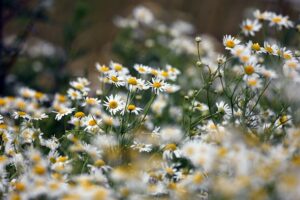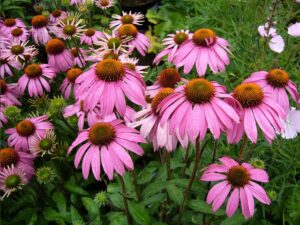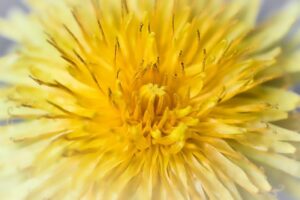Introduction
Embarking on a journey into the enchanting world of woodland herbs is like stepping into nature’s pharmacy. Nestled within the lush greenery of forests, these hidden treasures offer a bounty of medicinal properties and holistic remedies. Join us as we unveil the secrets and explore the fascinating benefits of woodland herbs.

Understanding the Magic of Woodland Herbs: History, Folklore, and Traditional Wisdom
Woodland herbs possess an enchanting allure that has captivated humanity for centuries. To truly appreciate their magic, let’s delve into the rich history, folklore, and traditional wisdom surrounding these remarkable plants:
a. Ancient Roots: Woodland herbs have deep historical roots, with evidence of their usage dating back to ancient civilizations. Explore the practices of herbalism in ancient Egypt, China, Greece, and other cultures, where these herbs were revered for their medicinal and spiritual significance.
b. Folklore and Mythology: Woodland herbs often have fascinating stories woven into folklore and mythology. Discover tales of magical properties associated with herbs like mistletoe, believed to bestow blessings and fertility, or the mythical healing abilities of plants like ginseng and valerian.
c. Traditional Healing Systems: Traditional healing systems, such as Ayurveda, Traditional Chinese Medicine (TCM), and Native American medicine, have long recognized the therapeutic potential of woodland herbs. Learn how these ancient systems integrated the use of herbs to restore balance and promote well-being.
d. Herbcraft and Wise Women: Throughout history, wise women, herbalists, and healers have carried the knowledge of woodland herbs. Uncover the secrets of herbcraft, passed down through generations, as these herbalists utilized the power of plants to address various ailments and maintain health.
e. Rituals and Ceremonies: Woodland herbs have been incorporated into rituals and ceremonies for their spiritual and transformative properties. From smudging with sage to purify spaces, to the ritualistic use of herbs during solstices and equinoxes, these practices connect us to the natural world and our ancestral traditions.
Understanding the magic of woodland herbs goes beyond their physical attributes. It embraces the cultural, spiritual, and historical significance they hold in different societies. By exploring their origins and traditional wisdom, we gain a deeper appreciation for the profound impact these herbs have had on human well-being throughout time.
As we embark on our journey into nature’s pharmacy, let us honor the ancient wisdom and embrace the timeless allure of woodland herbs. By tapping into their hidden treasures, we can unlock the secrets of holistic healing and embark on a transformative path towards well-being and connection with the natural world.
Exploring the Medicinal Powers of Woodland Herbs
Woodland herbs possess a wealth of medicinal powers that have been recognized and utilized for centuries. Their natural compounds and therapeutic properties offer a wide range of health benefits. Let’s delve deeper into the remarkable healing capabilities of these herbs:
a. Digestive Health: Many woodland herbs provide relief and support for various digestive issues. For example, peppermint can help alleviate bloating and indigestion, while ginger aids in soothing nausea and improving digestion. Explore the soothing properties of chamomile to ease gastrointestinal discomfort and promote overall digestive well-being.
b. Respiratory Support: Woodland herbs have been valued for their ability to address respiratory ailments. Thyme, with its antimicrobial and expectorant properties, can help alleviate coughs and congestion. Eucalyptus, known for its decongestant effects, can provide relief from respiratory conditions such as colds and sinusitis.
c. Stress Relief and Relaxation: Many woodland herbs possess calming and stress-relieving properties. The delicate flowers of lavender are renowned for their ability to promote relaxation and improve sleep quality. Lemon balm, with its gentle sedative effects, can help reduce anxiety and enhance a sense of calm.
d. Immune Boosters: Woodland herbs are often packed with immune-boosting compounds. Echinacea, a powerful herb, is believed to strengthen the immune system and help fight off infections. Elderberry, rich in antioxidants and vitamins, can provide immune support and help prevent colds and flu.
e. Anti-Inflammatory Benefits: Some woodland herbs contain anti-inflammatory compounds that can assist in managing inflammation-related conditions. Turmeric, renowned for its curcumin content, exhibits potent anti-inflammatory properties. Willow bark, a natural source of salicin, offers relief from pain and inflammation.
f. Skin Health: Woodland herbs can also contribute to vibrant and healthy skin. Calendula, known for its soothing properties, can help soothe irritated skin, minor wounds, and insect bites. Plantain, with its antimicrobial and anti-inflammatory effects, aids in promoting skin healing and relieving itching.
g. Hormonal Balance: Certain woodland herbs can support hormonal balance in the body. Black cohosh, for instance, is known for its potential to alleviate menopausal symptoms such as hot flashes and mood swings. Red clover is often used to address hormonal imbalances and promote overall reproductive health.
As with any herbal remedy, it’s essential to consult with a healthcare professional or herbalist before incorporating woodland herbs into your wellness routine. They can guide you in determining the appropriate dosage, potential interactions, and overall suitability based on your specific health needs.
Embarking on a journey into nature’s pharmacy through the exploration of woodland herbs provides a gateway to holistic well-being. Their medicinal powers, combined with responsible usage and informed guidance, can unlock a world of natural remedies for a healthier and more balanced life.
Common Woodland Herbs and Their Uses: Unlocking Nature’s Medicinal Arsenal
Woodland herbs encompass a diverse array of plant species, each with its own unique set of properties and uses. Let’s delve into the world of common woodland herbs, exploring their characteristics and the specific applications that make them valuable in promoting health and well-being:
a. Chamomile (Matricaria chamomilla): Known for its calming and soothing properties, chamomile is often used to alleviate stress, anxiety, and insomnia. It is also prized for its anti-inflammatory benefits, aiding in the relief of digestive issues such as bloating and indigestion.

b. Echinacea (Echinacea purpurea): Echinacea is renowned for its immune-boosting properties, making it a popular choice for fighting off colds and flu. This herb stimulates the production of white blood cells and enhances the body’s natural defense mechanisms, helping to shorten the duration of illness.

c. Yarrow (Achillea millefolium): With its potent anti-inflammatory and antiseptic properties, yarrow has been traditionally used to treat wounds, promote healing, and alleviate minor skin irritations. It is also known to have astringent qualities, making it valuable for managing bleeding and reducing excessive menstrual flow.
d. St. John’s Wort (Hypericum perforatum): St. John’s Wort is prized for its mood-enhancing properties, often used as a natural remedy for mild to moderate depression and anxiety. It is believed to increase the levels of neurotransmitters such as serotonin, promoting feelings of well-being and emotional balance.
e. Valerian (Valeriana officinalis): Valerian is a well-known herb used for its calming and sedative effects. It is frequently utilized to promote relaxation, alleviate insomnia, and reduce anxiety. Valerian has been a trusted remedy for improving sleep quality and addressing nervous system disorders.
f. Nettle (Urtica dioica): Nettle is a nutrient-rich herb known for its detoxifying properties and ability to support overall health. It is commonly used to alleviate allergies, boost circulation, and aid in maintaining healthy skin. Nettle leaves are also a source of essential minerals and vitamins, making it a valuable addition to one’s diet.
g. Dandelion (Taraxacum officinale): Dandelion is a versatile herb renowned for its diuretic properties, supporting kidney function and promoting detoxification. It is also rich in antioxidants and nutrients, making it beneficial for liver health, digestion, and overall vitality.

These are just a few examples of the abundant woodland herbs and their diverse uses. From calming and healing properties to immune-boosting and revitalizing effects, nature’s pharmacy offers a wide range of remedies rooted in these remarkable plants. Remember, it is essential to seek guidance from qualified herbalists or healthcare professionals to determine the appropriate usage and dosage based on individual needs and health conditions.
As we uncover the potential of common woodland herbs, we gain a deeper appreciation for the natural remedies available to us. Embrace the wisdom of nature and explore the vast possibilities these herbs provide, as you unlock the treasures of holistic well-being and tap into the power of woodland botanicals.
Harvesting and Preparing Woodland Herbs
Discover the best practices for responsibly harvesting woodland herbs and preserving their potency. We’ll delve into various methods of preparation, including drying, infusing, and making herbal extracts. By mastering these techniques, you can ensure that you’re harnessing the full potential of these natural treasures.
Incorporating Woodland Herbs into Daily Life
Learn how to integrate woodland herbs into your daily routine to maximize their benefits. Whether it’s adding fresh herbs to culinary creations, incorporating them into skincare products, or creating herbal remedies, we’ll provide practical tips and ideas to make the most of these natural wonders.
Exploring Sustainable and Ethical Practices for Woodland Herb Harvesting
As we embark on this journey into the world of woodland herbs, it is essential to prioritize sustainable and ethical practices to protect these delicate ecosystems. Responsible harvesting ensures the preservation of these valuable resources for future generations. Here are some additional considerations and guidelines to follow:
a. Respect for Nature: When harvesting woodland herbs, it’s crucial to have a deep respect for nature. Avoid over-harvesting or damaging the surrounding flora and fauna. Take only what is needed, leaving a sufficient amount for the plants to regenerate and thrive.
b. Identification and Preservation: Accurate identification of woodland herbs is vital to prevent the accidental harvesting of endangered or protected species. Familiarize yourself with local regulations and guidelines to ensure that you’re harvesting sustainable and legal herbs.
c. Sustainable Harvesting Techniques: Opt for sustainable harvesting techniques that promote the growth and longevity of woodland herbs. For example, selectively harvesting mature plants while leaving young ones undisturbed allows for natural propagation. Avoid uprooting entire plants unless necessary.
d. Cultivation and Conservation: Consider cultivating woodland herbs in a controlled environment. By growing these plants in your garden or supporting local sustainable herb farms, you reduce the pressure on wild populations. Encourage conservation efforts and participate in initiatives aimed at preserving these valuable resources.
e. Supporting Local Communities: Engage with local communities involved in sustainable herb harvesting. By purchasing herbs from trusted sources that prioritize ethical practices, you support the livelihoods of those who depend on these resources. This helps foster a sustainable cycle of production and consumption.
f. Knowledge Sharing: Share your knowledge and passion for woodland herbs with others. Educate friends, family, and fellow enthusiasts about sustainable harvesting practices, the importance of biodiversity, and the benefits of supporting ethical herb sourcing. By spreading awareness, we can collectively protect these invaluable ecosystems.
By following these sustainable and ethical practices, we can ensure the continued availability of woodland herbs for generations to come. Let’s embrace our role as stewards of nature and preserve the hidden treasures of woodland herbs, safeguarding their medicinal benefits and the delicate balance of our natural world.
Conclusion
Unveiling the hidden treasures of woodland herbs opens the door to a world of natural healing and wellness. Through our journey into nature’s pharmacy, we’ve discovered the power and versatility of these remarkable plants. By incorporating them into our lives with respect and understanding, we can tap into the true potential of woodland herbs and embrace the bountiful gifts of nature. So, step into this captivating realm and embark on your own journey of herbal exploration.
For more on the medicinal properties of herbs click here.
for more on home remedies click here
Resource: https://chestnutherbs.com/budding-herbalist-guide/

